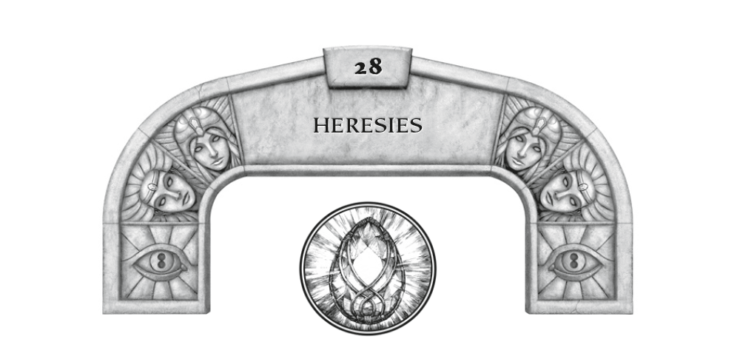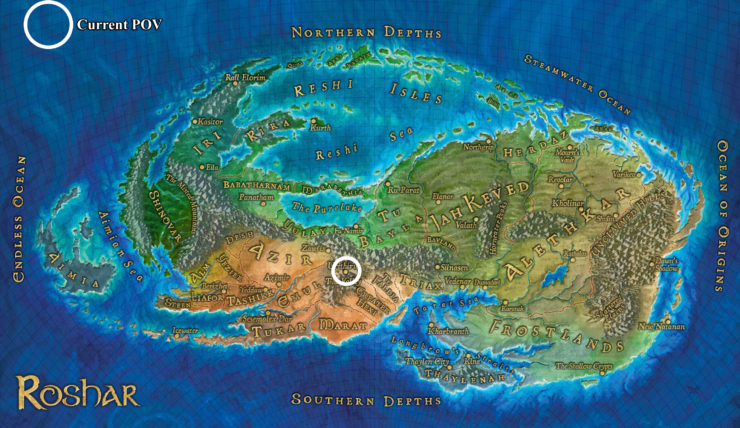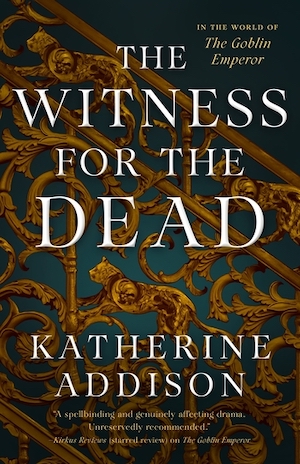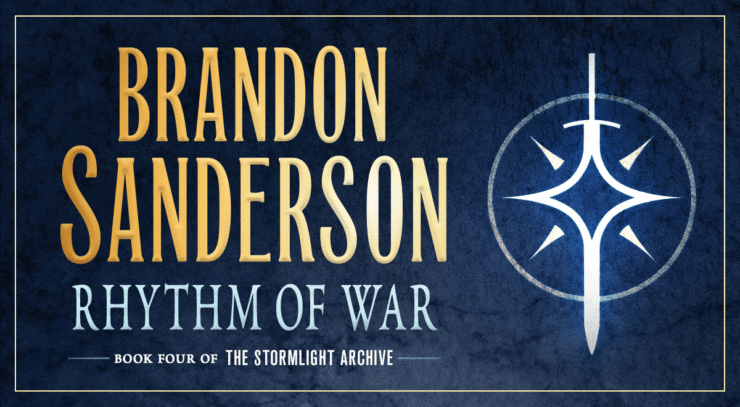Hello out there, O Cosmere friends!
Lyn: Chickens, Alice! Chickens! (I’ll win her over yet)
Alice: (Honestly, I love it, but I’m never sure I can pull off the usage. I’ll give it a shot, though…) Chickens, Cosmerans, Countrymen, lend me your ears! Welcome back to the Rhythm of War reread!
L: Yessssss.
A: We have a short chapter this week, but full of interesting things to discuss. Navani has finally heard from her mysterious spanreed correspondent again, and she was prepared. It pays off, too. Come on in and join the conversation.
Reminder: We’ll be discussing spoilers for the entirety of the series up until now. If you haven’t read ALL of the published entries of the Stormlight Archive (including Edgedancer and Dawnshard as well as the entirety of Rhythm of War), best to wait to join us until you’re done.
In this week’s discussion we also discuss some things from Mistborn (all eras) in the Epigraph section, so if you haven’t read it, best to give that section a pass. Definite spoilers, there.

Heralds: Chana, (Chanarach), Herald of the Common Man. Dustbringers. Brave/Obedient. Role: Guard. Palah (Paliah). Truthwatchers. Learned/Giving. Role: Scholar.
A: Chana and Palah, eh? Palah is pretty easy, because Navani’s scholarly approach to learning more about her correspondent is key to this interchange. All the measuring devices and triangulation and all that? Sure; the scholar. Chana, though… Her associated gemstone is ruby, which is critical for spanreed communication (and the gemstone that Navani deliberately destroys at the end), but that seems an odd connection to make with the Herald.
L: Yeah, the ruby connection is the only one that really makes sense to me for this one.
Icon: Artifabrian—A Navani POV chapter
Epigraph:
Other Shards I cannot identify, and are hidden to me. I fear that their influence encroaches upon my world, yet I am locked into a strange inability because of the opposed powers I hold.
A: A quick search through the epigraphs tells us that he knows about most of the Shards; the only ones not mentioned are Autonomy and the two unknowns. He’s probably right about their influence encroaching on his world; that “red haze” surrounding Scadrial (The Bands of Mourning) is a strong hint, since we know that red coloration generally indicates the corruption of one Shard’s Investiture by another Shard. There’s a standing theory that Autonomy is trying to mess with Scadrial, but as far as I know, that’s mostly based on the name Trell.
L: Not sure what you mean by that, can you elaborate?
A: The name Trell pops up a few different places. Sazed talks about a religion called Trelagism, whose followers had worshipped the stars, calling them “the thousand eyes of their god, Trell, watching them.” In Era 2, there’s hard evidence of a being known as Trell whose followers are actively trying to direct world events on Scadrial; there’s even a god metal for this person. The connection to Autonomy is (as far as I know) only through the person called Trell in White Sand—which takes place on Taldain, Autonomy’s primary world. It seems like an odd connection, because that Trell is a construction foreman; Sanderson did say the name was not a coincidence, but also that the connections might be “obtuse.” Whatever that means. So there’s a theory that Trell is an avatar of Autonomy, and so far Sanderson hasn’t shot it down.
In any case, someone with god-level powers is trying to influence things (there is a lot more on this in TBoM than just the red haze). It’s a bit scary that the person holding and balancing Ruin and Preservation, while it’s generally good for his planet, is a bit “locked up” in terms of dealing with other shards. I hope he can handle it!
Chapter Recap
WHO: Navani
WHERE: Urithiru
WHEN: 1175.4.3.4 (immediately following Chapter 27)
(Note: For the “when” notations, we are using this wonderful timeline provided by the folks at The 17th Shard.)

Navani and her scholars attempt to determine the location of the person on the other end of the strange spanreed, and learn two things; one, that it is a spren, and two, that it is located within the tower.
Overall Reactions
A: This chapter centers so much on the conversation between Navani and the “mysterious correspondent” that it would be disruptive to break too much of it out into the units below. So… let’s just talk about the gist of it here, okay? I find it amusing that Navani, Queen of Urithiru, is being vehemently scolded:
Why have you ignored my instructions?
A: Just… boom. You naughty child, you aren’t doing what I told you to do.
L: Well, since we know the identity of the correspondent, it does make sense. Navani would be quite young in comparison to the Sibling!
A: Well… true. Okay, then. The only question I have is whether Navani was really as confused about the “instructions” as she says, or if she’s just being disingenuous with her “I’m not sure what exactly you expected of me.”
You must stop your experiments with fabrials, the reed wrote. I made it explicitly clear that you needed to stop. You have not. You have only increased your heresies. What is this you do, putting fabrials in a pit and connecting them to the blowing of the storms? Do you make a weapon of the spren you have trapped? Do you kill? Humans always kill.
A: First note: This is the source of the chapter title, “Heresies.”
Second note: “Putting fabrials in a pit” etc. is a reference back to chapter 19, with her kinetic energy storage. Windmills outside, with rubies conjoined to weights in a deep shaft, so that during a highstorm the weights are winched all the way to the top. She’s currently got people working on both personal and group lifts, testing them to work with these weights and even switch a device from one weight to another. This will become Important later on.
Third note: The mystery person assumes she will use the kinetic energy to power weapons—and honestly, I don’t put it past Navani for a skinny minute. Right now she’s focused on airships, with the lifts as an intermediate step for experimentation, but if she saw a practical use for a weapon that would help Dalinar more than the airships, she’d be all over it.
L: Oh yeah. She wouldn’t hesitate for a minute to make use of this in a martial sense, especially if it would potentially save the lives of humans.
A: Right now, though, she’s more concerned with her pen-pal, and is looking for clues.
“She references humans as a singer might,” Navani said, tapping the paper. “Either she’s one of them, or she wants us to think she is.”
A: That’s an interesting conclusion. While it’s true that the singers draw a distinction between themselves and the humans, there are ::ahem:: certain other beings around here that also are straightforward about being not-human. Or maybe she’s already assuming the other party can hear her…
Buy the Book


The Witness for the Dead
In any case, Navani is adept at lying, and is rarely even fazed when she’s caught. In a situation like this, I never entirely know how much we should believe—at least of what she says. “I will speak with my theological advisor” (while we move the fabrial and try to triangulate your position), for example. (I’m pretty sure we can trust what she’s thinking, at least as far as she knows the truth; it’s just what she says that I’m not sure about!) I adore Navani, but I’ll admit to a snicker when her clever plan is… not so clever. “Why did you move?” indeed.
L: But even then, “why did you move” tells her something. Now she’s learned that the correspondent can see them, or at least is in contact with someone who can. I wouldn’t have put it past her to suspect this as well, and that this movement was also intended to determine whether it was true. She certainly isn’t fazed by the answer, which leads me to believe that she expected it or was testing it as well.
A: Good point. She doesn’t seem surprised by much of anything in this process. She certainly was prepared to do a lot of testing, and she doesn’t waste time being surprised by any of the information she gets; it’s all just useful data.
Humans cannot be trusted. You do not know how to keep promises, and promises are what make the world function. We make the world function. You must release your captive spren. You must you must.
“Ash’s mask…” Kalami said. “It’s a spren, isn’t it?”
“Yes,” Navani said.
A: So… how long has Navani really suspected this? I don’t know what to think. But this paragraph… In hindsight, it’s 100% obvious that this is a Bondsmith spren. “Promises are what make the world function. We make the world function.” That connection is just unavoidable. I do find it interesting that she’s so confident that it’s not another Unmade, even though that’s the example she gives Kalami for why she suspected a spren. Well, whatever she was thinking before, she’s clearly making the connection now.
Navani stumbled and—trying to make it appear as accidental as possible—dropped the spanreed while walking. She cried out as she clumsily kicked it across the stone plateau—right over the edge. …
“Damnation,” she said. “That’s terrible.”
Kalami eyed her, walking up. Navani smothered a smile.
A: Will this subterfuge work any better? If the other person decides it was deliberate, it seems like they just might start doing more direct sabotage. After all, they said earlier that “I will not suffer it for much longer.” That implies an ability to stop her by more… direct means. On the other hand, if they accept it as an accident, there’s a possibility Navani can find out who’s doing the physical part of the interaction. Yes, we know the answer by now, but it was a risk.
Music, Mechanisms and Manifestations of Light
“Judging by the weight of your pen once the conversation is engaged, we should be able to tell how far away the other pen is.”
A: Every so often, I see another fan talking about how this book would have been better with less of Navani’s technical stuff and more of ______ (fill in the blank with whatever they thought needed more words). I can understand that it doesn’t appeal to everyone, but to all those who are enjoying “representation”—this is mine, and I will never agree that the book would be better without it. This chapter just has a few details about the weight of the pens and the delay in conjoined gemstones, along with passing mention of triangulation to locate the sender, but I’m eating it up. Later, when we get into the manifestations of light? Oh, don’t you dare tell me it’s unnecessary. That is MY representation, I tell you!
(Secret fascination: I’ve been fond of the concept of triangulation since I was in sixth grade and learned how the fire lookouts used it to locate lightning strikes. My oldest sister worked on a fire lookout in Montana’s Flathead National Forest several summers when I was a kid, and would occasionally let one of the “little girls” come stay with her for a week or so. I was a little disappointed not to be able to actually help triangulate a smoke column, because we didn’t have any serious thunderstorms while I was up there, but my sister painstakingly demonstrated all the equipment and pointed out the other lookouts that would participate, depending on where the smoke was. At eleven years old, it apparently didn’t register that watching a forest fire start might not be the best experience… but living on a fire lookout was pretty cool anyway. Primitive, but cool.) (Also, my sister is highly amused that I’m telling this. I had to ask her whether Elbow Lake Lookout was in the FNF, or in the Bob Marshall Wilderness. The lookout itself isn’t there anymore. On top of that, she had to correct my age!)
L: Is all the science talk my cup of tea? Nope! But other people, like Alice, love it and that’s awesome. Not every character is going to appeal to everyone.
Spren and Shadesmar
The church sees no moral problem with fabrials. No more than they have a problem with hitching a chull to a cart.
A chull hitched to a cart is not confined to a tiny space, the reply came, the pen moving furiously, animatedly. Spren are meant to be free. By capturing them, you trap nature itself. Can a storm survive if placed in a prison? Can a flower bloom with no sunlight? This is what you do. Your religion is incomplete.
A: Well, I certainly agree that their religion is incomplete, based on what we already know! But I’d thought of it more in terms of not knowing the history behind their doctrine; this is a different aspect. This is a question we’ve debated since we first learned that fabrials function by trapping spren in gemstones, and it doesn’t get any clearer here.
L: Yeah, this is a tough one. And since the spren in question aren’t sapient, it’s not like Navani can just ask one its opinion on being trapped!
Each moment you wait is a moment of pain brought to the spren you dominate.
A: Are they really in pain? It seems that the Sibling would know more than the humans, but they’ve had this conversation, and it seems no one has changed their mind. Back in Chapter 9, Navani stated that the Radiant-bonded spren she’d talked to (we don’t know who that included) had agreed that the spren in the fabrials were not thinking creatures and the practice was acceptable. Not that they necessarily liked it, but they didn’t really object either—not even the honorspren.
L: This is a really interesting conundrum. We have one (albeit big and powerful) spren telling us one thing, but others telling us something else. Which do we trust?
A: It doesn’t help that the big and powerful one seems to have a grudge against humans in general, because they didn’t much like their last Radiant. (I do hope we get more of that story sometime.)
Humans
Hair streaked with grey, the scribe had an increasingly worrisome leanness to her these days.
A: Kalami, you may remember, is one of the Kholin family’s most trusted scribes as well as a fine historian. She’s also the widow of Teleb, the Oldblood archer Dalinar co-opted in the first flashback of Oathbringer. I don’t recall that this “worrisome leanness” is ever addressed again, but I do wonder about it, and whether she survived the occupation.
Falilar’s little apprentice—Isabi, daughter to one of the Windrunners—seemed ready to burst as she held her breath.
A: I suspect (though I don’t know) that Isabi is a tuckerization for the daughter of a member of Team Dragonsteel. If I’m guessing right, the parent has popped up as a Windrunner from time to time.
We’ll be leaving further speculation and discussion to you in the comments, so have fun and remember to be respectful of the opinions of others! For what it’s worth, we considered the suggestion to do more than one chapter a week, and while this one is quite short, the next one is too long to want to combine them. We’ll look at it on a weekly basis, and combine short chapters if we think it makes sense.
Next week, we’ll be back with just Chapter 29, “A Cage Without Bars,” on the barge with Shallan, Adolin and co.
Alice has now completed her isolation, and none the worse for wear. One family member tested Covid-positive, but no one had any symptoms. So… yay? Also, spring is springing.
Lyndsey has been a Sanderson beta reader since Words of Radiance and is also a fantasy author herself. She’s been doing weekly tie-in videos to the reread and silly cosmere cosplay vids on TikTok, or you can follow her on Facebook or Instagram.










